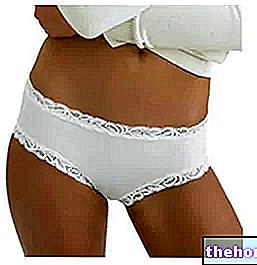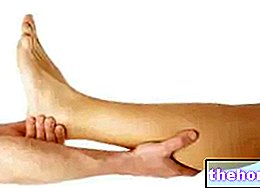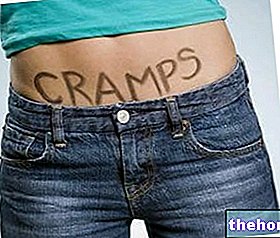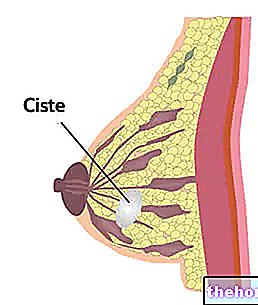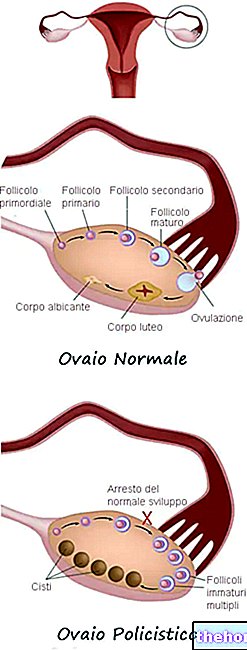Menstrual cups: what are they?
An alternative to the classic tampons are menstrual cups: these are small latex or silicone containers to be inserted inside the vagina during menstruation, in order to gather menstrual flow.

Menstrual cups cover the cervix just like a contraceptive diaphragm; however, unlike the latter, menstrual cups do not fall on the list of birth control methods.
Menstrual cups offer no protection from unwanted pregnancy or sexually transmitted diseases
The use of menstrual cups dates back to 1930, but in our country it does not seem to be a practice particularly appreciated by the female world. In Italy women prefer to use external tampons or tampons during menstruation, probably because menstrual cups are still little known or advertised.
Types, shapes and sizes
The market offers two types of menstrual cups:
- Menstrual cups shaped (the most used): these are "bell" devices made of rubber, latex, silicone or hypoallergenic material. The best known brands are Lunette, The Mooncup, Softcup And Fleurcup (colored menstrual cups). This type of menstrual cup is reusable and, if used correctly, can last up to 10 years: in fact, after removal from the vagina, the cup must be carefully washed with water and neutral soap, and dried. After that, the cup can be reinserted. Despite the foregoing, some manufacturers still recommend replacing the cup once a year for hygienic reasons. Reusable cups must be removed before consuming full sexual intercourse.
- Menstrual cups in polyethylene (produced exclusively by the company Instead): the shape of these containers resembles that of contraceptive diaphragms. Two further variants can be distinguished in this category:
- Disposable menstrual cups, designed to be disposed of after a single use
- Reusable menstrual cups (to throw away after a menstrual period)
Menstrual cups are not all the same: in addition to material and shape, they also differ in terms of size.
In fact, there are small, medium and large cups: every woman can choose the size that best suits her body. For example, the small they are suitable for young women who have not yet given birth; larger sizes fit better on the cervix of women who have had a vaginal birth. However, large menstrual cups should also be considered by women who, despite not having given birth yet, suffer from hypermenorrhea (heavy menstruation).
Menstrual cups have a stem, designed to facilitate the removal of the collector. Some cups have a stem that is too long for a woman's genital anatomy: in this case, the shaft can be shortened with a cut of scissors as needed. Some menstrual cups are built with rounded, blunt or "arched" stems, such as to allow perfect adaptation to the genital anatomy and easy removal.
Below are the approximate sizes of the best-selling menstrual cups
Menstrual cups on Amazon

This menstrual cup made in Italy is designed to collect the menstrual flow in a natural and hygienic way.
The device, made of certified medical grade platinum silicone, inserts into the vagina after folding, empties every 4-8 hours and lasts up to 10 years, and is a modern, safe, ecological and economical solution that simplifies the cycle.
It can also be used at night, during sports and when traveling, as it is practical, easy to use and clean.
The choice of size, between size M and L, depends above all on the tone of the pelvic muscles (the muscles that hold the cup in position inside the vagina).
Tonicity is affected by:
- children: when you give birth in a natural way, the passage of the baby can change the shape of the vagina. Usually after a natural birth you need a larger cup, size L;
- age: with advancing age usually (but not necessarily) the tone of the pelvic floor decreases. Therefore, after the age of 30, the large size is recommended, while the small size is always recommended for very young girls;
- physical fitness: if a woman is very sporty, her general muscle tone is usually higher, which is why a small size, or M, may be indicated, even if she is over 30 years old.
The difference in size between the two sizes is small, but it is of great importance. A cup that is too small may move, while a cup that is too large may struggle to open in the vagina.

An excellent alternative to a tampon, this menstrual cup, extremely easy to clean, adheres perfectly to the vaginal walls to collect the flow, guaranteeing up to 12 hours of protection.
Excellent for traveling, playing sports, going to the beach or swimming pool, it is made of soft medical grade silicone, free of BPA or other harmful substances, safe and FDA certified.
It is available in two sizes: size S, recommended for women under 30 and who have not yet given birth, and size L, recommended for women over 30 and / or who have already given birth.
Insertion mode
Contrary to what one might believe, menstrual cups are quite simple to insert and guarantee absolute discretion. The correct insertion of the cup is essential to make the most of the effectiveness of this "innovative" device.
The correct method of use is described in steps below:
- Wash your hands thoroughly
- Discard the menstrual cup from the package
- Fold it on itself, first once, then a second, to facilitate insertion
- Insert the cup into the vagina at any time during the menstrual cycle. If necessary, apply a lubricant before inserting the menstrual container
- The reusable menstrual cup tends to position itself correctly by itself, without necessarily pushing it deeply into contact with the uterine cervix. The menstrual cup must be completely inserted into the vaginal canal, with the widest opening upwards and the stem downwards (which will later be used for removal).
- The disposable menstrual cup must first be inserted in the middle of the vaginal trunk, then pushed behind the pubic bone, near the uterine cervix. At this point, the cup adjusts to the genital anatomy.
- Remove the menstrual cup: to remove the cup, simply push it down with the help of the pelvic muscles. Then remove the container by pulling the stem of the cup outwards.
- Empty the menstrual cup every 4-8 hours. For low / low menstruation, the menstrual cup can be emptied every 12 hours.
- Rinse with soap and water
- Dry the cup thoroughly
- Reintroduce it into the vagina
Between menstruation, it is recommended that the menstrual cup be boiled in water for sterilization.
Advantages and disadvantages
Although menstrual cups have numerous advantages, the other side of the coin shows negative aspects about their use.
- Economic savings: a menstrual cup (about € 12-20) can ideally be reused for 10 years, reducing purchase costs
- Respect for the environment: it is estimated that a woman uses approximately 10,000 internal or external sanitary pads, which are inevitably thrown away. A menstrual cup can last a long time without polluting the environment
- The presence of the menstrual cup - if positioned correctly - is not perceived by the woman
- Menstrual cups have a greater capacity than internal tampons: in this regard, the frequency of the "change" is reduced
- Menstrual cups can be used in the pool or in the sea
- Ease of use
- Does not absorb normal vaginal secretions (disadvantage of internal tampons)
- Menstrual cups can be held in place even while urinating or defecating
- Some menstrual cups can be held in place during intercourse
- Women prone to candidiasis or other vaginal infections should not use menstrual cups as pathogens could lurk in the collector
- Latex menstrual cups can create allergic reactions (in women predisposed / allergic to latex)
- Boil the menstrual cup in water between periods for greater hygiene
- Initially, the woman may take longer to insert the menstrual cup than with vaginal tampons
- It may be necessary to lubricate the vaginal canal with specific creams to facilitate the insertion of the menstrual cup
- Women who use the intrauterine device IUD as a contraceptive method should pay particular attention to the insertion of menstrual cups.
- Do not insert menstrual cups in case of vaginitis, cervicitis, cervical malformations and vaginal erosions
- During the first few applications, many women turn to their doctor because they cannot position their menstrual cups correctly


